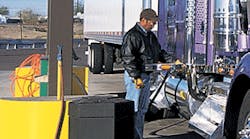Following the Environmental Protection Agency’s (EPA) recent announcement that it has extended the deadline for retail outlets to provide ultra-low sulfur diesel (ULSD) fuel at the 15 parts per million (ppm) level, the Engine Manufacturers Association (EMA) has re-affirmed the need for on-time delivery of the cleaner fuel.
The extension of the compliance date will require 22 parts per million (ppm) sulfur diesel to fuel on-highway vehicles in the period from Sept. 1 to Oct. 15, 2006 and 15 ppm diesel afterward. Originally, retail outlets were required to switch to 15 ppm on-highway diesel by Sept. 1. Current retail on-highway diesels are at the 500 ppm level.
EPA said the transition period will not interfere with the planned introduction of 2007 emissions-compliant vehicles and engines or reduce the environmental benefits of its Clean Diesel Program.
See ULSD deadline extended 45 days.
Besides EMA’s concern that any delay at the retail level would have a negative environmental impact, it could have costly implications for engine makers as well.
“As we introduce these significantly cleaner engines and vehicles, potential buyers need the assurance that the appropriate diesel fuel required by this new technology will be available as promised,” said EMA president Jed Mandel.
“Engine manufacturers have done their part and are ready with the engine and aftertreatment technology needed to meet the 2007 emission standards,” he noted. “Oil and pipeline companies and the EPA must assure that diesel fuel that fully complies with the established standards is available and delivered on-time. Any backsliding is unacceptable from a vehicle engineering and air quality viewpoint.
The transition period would accommodate refiners who were concerned that ULSD would not reach the 15 ppm level due to mingling with pipelines and equipment that typically transport higher-sulfur diesel, according to EPA.
“ULSD fuel is the third leg in the systems approach and is a necessary prerequisite that enables the successful emissions reductions,” EMA’s Mandel warned. “There can be no slippage in the delivery schedule or quality of the fuel.”




